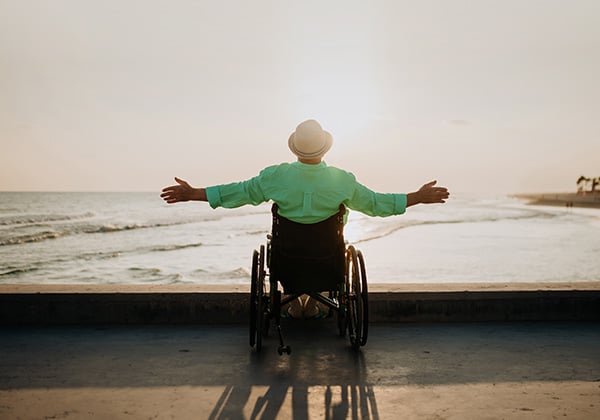Managing your incontinence
Navigating a night away with incontinence
We all love a change of scenery. Maybe you’re looking forward to a quick getaway, a trip to see family or a well-earned holiday. Incontinence shouldn’t hold you back from enjoying a trip away. So, how do you navigate a night away with incontinence?

Why do adults experience bed wetting?
Incontinence while sleeping, known as nocturnal enuresis, can affect people who are completely incontinent and those who are continent most of the time.
Night-time bedwetting is not within your control. Your brain sends a message that triggers your bladder to release urine. It may happen because you:
- Live with incontinence all the time
- Have an overactive or unstable bladder
- Have a urinary tract infection
- Are taking medications with side effects that weaken your urinary system (including common drugs used to treat heart and blood pressure conditions, anxiety or other mental health conditions)1
How do you manage night-time bedwetting at home?
Waking up in wet sheets isn’t a pleasant experience for anyone – and can be embarrassing if you share the bed with someone.
It also disrupts your sleep (and theirs). Over time, tiredness may deepen and could begin to affect your quality of life.
Once you recognise that night-time incontinence is a problem, you’re able to respond appropriately. This may involve:
- Seeing your doctor – they may be able to review medications or test you for any underlying conditions that may be affecting your continence
- Using a bed mat – this is easier to change than your bedsheets
- Wearing an absorbent continence product while you sleep – when you wake up, you can change and clean your skin, and your clothes and bedsheets should still be dry
Every time you (and your partner) get a good night’s sleep represents a wee win over incontinence.
How do you plan for a good night away?
Incontinence can have a significant psychological impact. It’s easy to become isolated, stressed and overwhelmed.2 This highlights the increased significance of engaging in activities that bring joy and rejuvenation, such as going for a few nights away.
Planning ahead means you’re prepared. Consider how each aspect of your trip could be affected by incontinence and plan accordingly.
Before you travel
Many people benefit from training their pelvic floor muscles to improve continence.3 Talk to your doctor or physiotherapist for personalised advice on this.
If you’re travelling by coach, train or plane, then consider where you want to sit. You may prefer to sit on the aisle, near the toilet or the front where you can get on and off easily. If you’re travelling by car, use the National Public Toilet Map to find toilets along your route.4
Pack well for your trip bearing incontinence in mind. It can mean working out how many bed mats, absorbent products and skin care products you need.
Before your journey, avoid food and drinks that may irritate your bladder. That includes coffee, tea, alcohol, chocolate drinks, fizzy soft drinks, sports drinks and spicy or acidic foods.5
The journey
Choose your clothes carefully. You want something comfortable that’s easy to remove quickly when you need the toilet.
It’s a good idea to pack some moist tissues – such as MoliCare’s Skin Moist Skin Care Tissues for areas affected by incontinence.
You may feel more secure if you wear an absorbent continence product while you travel. For some people, this is essential. For others, it’s a helpful back-up in case they can’t access the toilet in time. It can be particularly helpful if you experience:
- Incontinence when sleeping – many of us nod off on long journeys!
- Urge incontinence6 – you don’t always have quick access to a toilet when you’re travelling
At your accommodation
Once you arrive at your accommodation, get yourself organised for a good night’s sleep. This could include placing a bed mat on the bed and organising your skin care products in the bathroom.
How can we help?
MoliCare offers a comprehensive approach to incontinence management by combining MoliCare absorbent products with MoliCare Skin care products.
This combination, known as the MoliCare Skintegrity System, helps to maintain a healthy skin pH balance and help prevent the occurrence of Incontinence Associated Dermatitis (IAD).
Finding a product that’s the right style, absorbency and size to contain each episode of incontinence is important. Before your trip, we encourage you to explore the MoliCare range using our product finder and order free samples.
When you’re well-informed and well-prepared, living with incontinence gets a little easier. Download your copy of The complete guide to incontinence management today.
Disclaimer
This website does not provide medical advice. The information, including but not limited to, text, graphics, images, and other material contained on this website, is for informational purposes only. No material on this site is intended to be a substitute for professional medical advice, diagnosis, or treatment. Always seek the advice of your physician or other qualified healthcare provider with any questions you may have regarding a medical condition or treatment and before undertaking a new healthcare regimen. Never disregard professional medical advice or delay in seeking it because of something you have read on this website.
Endnotes
1. Bladder and Bowel, Understanding nocturnal enuresis, include URL [Accessed 12 July 2023]
2. Continence Foundation of Australia, Psychological impact, include URL [Accessed 12 July 2023]
3. Continence Foundation of Australia, Pelvic floor muscles, include URL [Accessed 12 July 2023]
4. Australian Government, Department of Health and Aged Care, National Public Toilet Map, include URL [Accessed 12 July 2023]
5. Continence Foundation of Australia, Travel tips, include URL [Accessed 12 July 2023]
